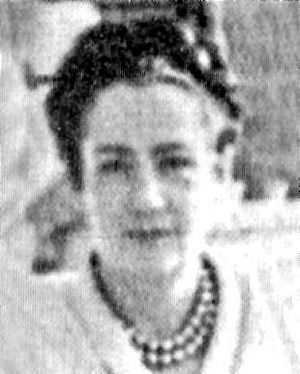Mercedes Comaposada facts for kids
Quick facts for kids
Mercè Comaposada i Guillén
|
|
|---|---|
 |
|
| Born | 14 August 1901 |
| Died | 11 February 1994 (aged 92) |
| Nationality | Catalan |
| Occupation | Lawyer, teacher |
| Organization | Mujeres Libres |
| Movement | Anarcha-feminism |
| Opponent(s) | Nationalist faction |
| Partner(s) | Baltasar Lobo |
Mercè Comaposada i Guillén (also known as Mercedes Comaposada Guillén) was a smart and active woman from Catalonia, Spain. She was born in 1901 and passed away in 1994. Mercè was a teacher, a lawyer, and a supporter of anarcho-feminism. This means she believed in freedom and equality for everyone, especially women. She helped start a very important group called Mujeres Libres (which means "Free Women") along with Lucía Sánchez Saornil and Amparo Poch y Gascón.
Contents
Early Life and Education
Mercè Comaposada i Guillén was born in Barcelona, Spain, on August 14, 1901. Her father, Josep Comaposada, was a shoemaker who believed in social justice. Mercè grew up in a family that cared a lot about making society better. She learned to type when she was just twelve years old.
She left school early to work as a film editor. This was for a company that made movies. Later, she joined a workers' union in Barcelona. This union was part of a bigger organization called the Confederación Nacional del Trabajo (CNT).
Mercè then moved to Madrid to study law. She learned from famous teachers like Antonio Machado. During this time, she also trained to be a teacher. She wanted to help other women get an education. It was in Madrid that she met Lucía Sánchez Saornil. Together, they came up with the idea for a women's group that would focus on freedom and learning.
Founding Mujeres Libres
In the 1930s, Mercè and Lucía taught basic classes to workers. These classes were for both men and women. But they realized that women needed special support. Many women faced unfair attitudes and were not encouraged to learn. So, they decided to create a group just for women.
In April 1936, Mercè, Lucía Sánchez Saornil, and Amparo Poch y Gascón officially started Mujeres Libres. This organization aimed to help women become more independent and educated. They wanted women to have the same opportunities as men.
Soon after, Mercè traveled to Barcelona. She convinced another women's group there to join Mujeres Libres. The organization grew very quickly. By 1938, it had more than 20,000 members. These members were workers and farmers from all over Spain.
The Mujeres Libres Journal
In May 1936, the first issue of the Mujeres Libres journal was published. This magazine shared ideas and news from the organization. It was published until 1938 and had 12 issues. Many important women wrote for the journal. These included Federica Montseny and Emma Goldman.
Mercè's partner, the sculptor Baltasar Lobo, also helped with the journal. He created illustrations for it.
Life During and After the Spanish Civil War
When the Spanish Civil War started, Mercè continued her work. She kept teaching and writing for newspapers that supported freedom.
After the war, the side Mercè supported, the Republicans, lost. This meant she had to leave Spain. She went to Paris, France, with her partner, Baltasar Lobo. They were helped by the famous artist Pablo Picasso. Mercè even worked as Picasso's secretary for a while.
In Paris, Mercè also worked as a translator. She translated books by Spanish writers into other languages. She also helped manage her partner's art career.
Even in exile, Mercè never stopped working for her beliefs. In the 1960s and 1970s, she continued to write for magazines. These included Mujeres Libres and Tierra y Libertad. After the death of Francisco Franco in 1975, Mercè thought about writing a book. She wanted to collect stories from other women about their experiences. Sadly, her manuscript disappeared after she passed away.
Selected Works
Mercè Comaposada wrote several books and articles. Here are some of her important works:
- Esquemas (1937)
- Las mujeres en nuestra revolución (1937) - This means "Women in Our Revolution."
- La ciencia en la mochila (1938) - This means "Science in the Backpack."
- Conversaciones cono los artistas españoles de la Escuela de París (1960, as Mercedes Guillén) - This means "Conversations with Spanish Artists of the Paris School."
- Picasso (1973, as Mercedes Guillén)
See also

- In Spanish: Mercedes Comaposada para niños (This link goes to a kid-friendly article about Mercè Comaposada in Spanish.)

